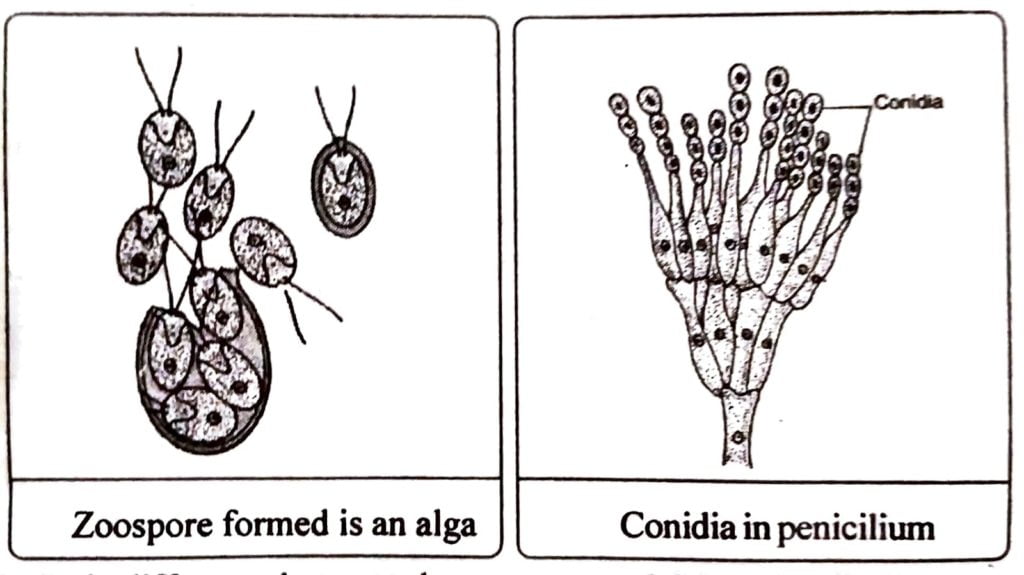Class 12 Biology Chapter 1 Reproduction in Organisms The answer to each chapter is provided in the list so that you can easily browse through different chapters Assam Board HS 2nd Year Biology Chapter 1 Reproduction in Organisms Question Answer.
Class 12 Biology Chapter 1 Reproduction in Organisms
Also, you can read the SCERT book online in these sections Solutions by Expert Teachers as per SCERT (CBSE) Book guidelines. These solutions are part of SCERT All Subject Solutions. Here we have given Assam Board Class 12 Biology Chapter 1 Reproduction in Organisms Solutions for All Subjects, You can practice these here.
II. QUESTIONS FOR (2 MARKS)
Q.1. What is life span? Name the different stages of life span of an organisms.
Ans : The period from birth to the natural death of an organism represents its life span. Every organism has a specific life span.
The different stages of life span are :
(i) Juvenility : It represents the stage when organisms develops the capacity to reproduce.
(ii) Maturity : In this stage reproduction starts.
(iii) Ageing and Senescence : The progressive deterioration in body of an organism is called ageing and the terminal irreversible stage of ageing is called senescence.
(iv) Death : It is the permanent cessation of all vital activities.
Q.2. Write down the differences between ovipary and vivipary nature of organisms.
Ans : The egg laying animals are called the oviparity and the animals which gives birth of young ones all called vivipary.
Q.3. Offspring formed due to sexual reproduction have better chances of survival, Why?
Ans : (i) Sexual reproduction introduces variations in offspring, hence of evolutionary significance.
(ii) It helps the offsprings to adjust according to changes in the 3. environment.
(iii) As a result of new character combination, better offsprings are produced, thus result is better varieties.
Q.4. Differentiate between oestrus and menstrual cycles.
Ans:
| Oestrus cycle | Menstrual cycle | ||
| (i) | It occurs in most of the mammals. | (i) | It occurs only in primates. |
| (ii) | Menstruation does not occur. | (ii) | Menstruation occurs at the end of cycle. |
| (iii) | Endometrium is reabsorbed. | (iii) | Endometrium goes out with menstrual flow. |
| (iv) | Hot period is found for copulation. | (iv) | At any time, they can copulate. |
Q.5. Differentiate syngamy from fertilization.
Ans : Syngamy is the union of two haploid gametes producing a diploid zygote. But in fertilization different events takes place which finally lead to syngamy.
Q.6. What are hermaphrodite organisms? Give the common names of one hermaphrodite organism each from both plants and animals.
Ans : The organisms bearing both the sexes are called hermaphrodite or monoecious. The common hermaphrodite plant is – Maize and common hermaphrodite animal is earthworm.
Q.7. Describe the significance of vegetative propagation.
Ans : Significance of vegetative propagation are :
(i) Character of the parent plants are preserved.
(ii) It is a quicker method.
(iii) It is a cheaper method of propagation.
(iv) It is the only method of reproduction in plants which don’t produces seeds.
(v) It is less expensive method of multiplying plants.
Q.8. Which type of plants shows successful grafting and why it is so?
Ans : Grafting is generally done between the related varieties of species. This method has been practiced for many economically useful plants, such as rose, mango, apple, pear, citrus, rubber etc. It is successfully done because the grafting mostly depends upon the union of the cambium of scion and stock which results the organic connection between them.
Q.9. Why a plant of lower cryptogams produces large number of antherozoids but relatively only few egg cells?
Ans : Large number of antherozoids are produced to make the fertilization as a sure shot process.
Q.10. Why papaya is said to be dioecious where as coconut is monoecious, inspite of both of them bears unisexual flowers?
Ans : Papaya is called dioecious because male and female flowers are present on different plant. But in case of coconut, it is called monoecious because a plant may have both male and female flowers. Moreover both the plants may have unisexual flowers.
Q.11. Why do internodal segments of Sugarcane faiis to propagate vegetatively even when they are in contact with damp soil?
Ans : Because the internodal parts of the sugarcane do not have the capacity to produce a new plant.
Q.12. Reduction division or meiosis can be associated with what type of reproduction and how?
Ans : Reduction division or Meiosis is associated with sexual reproduction. In sexual reproduction gametes are to form where chromosome number should be reduced to half. Hence in reproductive cells by meiosis, the chromosome number reduced to half which again maintain the number after fertilization i.e. by formation of zygote.
Q.13. Match the items in column ‘A’ with items in column ‘B’
| Column ‘A’ | Column ‘B’ |
| (a) Zygote | (i) Monocystis |
| (b) Clone | (ii) Genetically identical offspring |
| (c) Isogamy | (iii) Earthworm |
| (d) Bisexual animal | (iv) Embryo |
Ans:
| Column ‘A’ | Column ‘B’ |
| (a) Zygote | (iv) Embryo |
| (b) Clone | (ii) Genetically identical offspring |
| (c) Isogamy | (i) Monocystis |
| (d) Bisexual animal | (iii) Earthworm |
Q.14. Match the items in column ‘A’ with items in column ‘B’
| Column ‘A’ | ‘Column B’ |
| (a) Algae | (i) Conidium |
| (b) Hydra | (ii) Zoospore |
| (c) Penicillium | (iii) Budding |
| (d) Sponge | (iv) Gemmules |
Ans:
| Column ‘A’ | ‘Column B’ |
| (a) Algae | (ii) Zoospore |
| (b) Hydra | (iii) Budding |
| (c) Penicillium | (i) Conidium |
| (d) Sponge | (iv) Gemmules |
Q.15. Draw the sketches of a zoospore and a conidium. Mention a dissimilar and a common feature found between them.
Ans :

The main difference between the zoospore and the conidia that zoospores are motile and can move freely but the conidia are non motile.The common feature between the zoospore and conidia that both are the mode of asexual way of reproduction.
| Sl. No. | CONTENTS |
| Chapter 1 | Reproduction in Organisms |
| Chapter 2 | Sexual Reproduction in Flowering Plants |
| Chapter 3 | Human Reproduction |
| Chapter 4 | Reproductive Health |
| Chapter 5 | Principles of Inheritance and Variation |
| Chapter 6 | Molecular Basis of Inheritance |
| Chapter 7 | Evolution |
| Chapter 8 | Human Health and Disease |
| Chapter 9 | Strategies for Enhancement in Food Production |
| Chapter 10 | Microbes in Human Welfare |
| Chapter 11 | Biotechnology: Principles And Processes |
| Chapter 12 | Biotechnology and its Applications |
| Chapter 13 | Organisms and Populations |
| Chapter 14 | Ecosystem |
| Chapter 15 | Biodiversity and Conservation |
| Chapter 16 | Bioresources of Assam |
| Chapter 17 | Environmental Issues |
Q.16. How many kinds of natural vegetative reproduction takes place in flowering plants?
Ans : The natural vegetative propagation that takes place in flowering plants may be of following types :
(a) Vegetative propagation by roots : Sweet potato propagates by adventitious tuberan notes while in Goman, Sisso plants can multiply by the roots.
(b) Vegetative propagation by stem : It is found in case of Rhizome (e.g.. Ginger), stem tuber (sweet potato) and runner (wood sord) where the stem helps in multiplication of the plant.
(c) Vegetative propagation by leaf: Bryophyllum is the best example to multiply vegetatively by the leaf.
Q.17. In angiosperms pollen tube of germinated pollen carries two male gametes. What is the purpose of carrying two gametes when single gamete can fertilize the egg?
Ans : In angiosperms pollen tube of germinated pollen carries two male gametes. Out of these two male gametes,one is united with the egg all nucleus to form zygote and finally to form seed while the other male gamete united with secondary nucleus to form the endosperm.
Q.18. How does the progeny formed from asexual reproduction differ from that formed the sexual reproduction?
Ans : The progeny formed by asexual reproduction having the same genetic make up and the progeny formed by sexual reproduction are with different genetic characters because here mixing of maternal and paternal characters takes place.
Q.19. Differentiate between Parthenocarpy and Parthenogenesis.
Ans : Parthenogenesis is the formation of embryo directly from egg cell or a male gamete. It is a type of apogamy.
Sometimes fruits may be formed without the act of fertilization and then it is called as parthenocarpy. Normally they do not have the seed.

Hi, I’m Dev Kirtonia, Founder & CEO of Dev Library. A website that provides all SCERT, NCERT 3 to 12, and BA, B.com, B.Sc, and Computer Science with Post Graduate Notes & Suggestions, Novel, eBooks, Biography, Quotes, Study Materials, and more.




